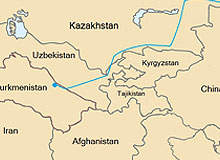
The 3,666km long Central Asia-China gas pipeline begins at Gedaim, on the Turkmenistan / Uzbekistan border, and ends at Horgos, in the Xinjiang region of China. The pipeline consists of dual parallel lines, Line A and Line B, each measuring 1,833km in length. The diameter of the pipeline is 1,067mm, with walls of 15.9mm and 19.1mm.
Line A was completed in 28 months and inaugurated in December 2009. Line B became operational in October 2010. The fourth compressor station in Kazakhstan was completed in December 2010. The total cost of the project is estimated at $7.31bn.
The China National Petroleum Corporation (CNPC) began construction of the pipeline in August 2007. CNPC Exploration and Development Company, a subsidiary of CNPC, executed the project.
The pipeline transported 4.38 billion cubic metres (bcm) of natural gas from fields in Turkmenistan, Uzbekistan and Kazakhstan to China’s gas transportation network in 2010. In April 2006, CNPC signed a contract with Turkmenistan for supplying natural gas to China for 30 years.
China and Uzbekistan signed an agreement in June 2010, under which Uzbekistan will provide 10bcm of natural gas a year to China. As part of the agreement, Uzbekistan’s gas pipeline network was connected to the Central Asia-China gas pipeline to supply natural gas.
Natural gas from Turkmen fields, such as the Samandepe gas field located near the Amu Darya River, is being fed to the pipeline. Fields in Kazakhstan, including Karachaganak, Kashagan and Tengiz, are connected to the pipeline. Gas fields in Uzbekistan also supply natural gas to the pipeline.
The natural gas supplied by the pipeline is expected to meet the growing energy demands of China. It is forecast that by 2012-13, it will have a delivery capacity of 40bcm a year.
It is also expected to reduce carbon dioxide emissions by 130 million tons (mt), sulphur dioxide emissions by 1.44mt and nitrogen oxide emissions by 0.36mt.
Central Asia-China gas pipeline construction and infrastructure
Construction of the pipeline was divided into different sections. In August 2007, construction began on the Turkmen section and work on the Uzbek segment started in June 2008. A month later, construction on the Kazakh section of the pipeline was initiated.
The route of the pipeline included various geographical features, such as uneven terrain including, for example, the soft riverbeds of the Ili and Syr Darya Rivers, which posed construction problems for engineers.
To address this problem, contractors used directional drilling-crossing technologies, placing 1.1km pipes 30m below the Ili riverbed without causing harm to the local environment.
Construction of line A was completed quickly using a new work method, which combined low-hydrogen welding and semi-automatic welding techniques. Using this technique, the contractors were able to reduce the consumption of welding rods by more than 30%.
In September 2011, CNPC and KazMunaiGas signed an agreement for construction of Line C of the pipeline in Uzbekistan. Construction of 1,840km long line C started in December 2011 and is expected to be completed by 2014. The Uzbekistan section of line C is 529km long and runs parallel to line A and B. It will have a capacity of 25bcm annually and will increase the total transmission capacity of the Central Asia-China pipeline to 55bcm annually.
Contractors with a role in the natural gas pipeline project
The Turkmenistani section of the pipeline was constructed by Stroytransgaz, a subsidiary of Gazprom, at a cost of $600m.
Other contractors included China Petroleum Pipeline Bureau, China Petroleum Engineering and Construction Corporation (CPECC) and Zeromax.
The contractor responsible for the Uzbek section of the pipeline was Asia Trans Gas, a joint venture formed between Uzbekneftegaz and CNPC.
The Kazakh section of the pipeline was constructed by the Asian Gas Pipeline company, a joint venture between CNPC and KazMunayGas. Other contractors included KazStroyService and CPECC.
Vyksa Steel Works, a subsidiary of the United Metallurgical Company, was contracted to supply a total of 355,000t of pipes for the Kazakhstan and Uzbekistan segments of the pipeline.
Pipeline route and connection of the international transportation network
About 188km of the pipeline passes through Turkmenistan, plus a further 530km from Uzbekistan to Kazakhstan. The remaining 1,115km runs from Kazakhstan to China.
In June 2010, an agreement was signed between China and Kazakhstan to construct the second phase of the Kazakhstan-China gas pipeline which is an important part of the Central Asia-China pipeline.
Phase two will be 1,480km long and travel towards the north of the Aral Sea. The pipeline will have a diameter of 1,016mm and carry about five to 10bcm of natural gas a year from the Caspian Sea to China.
Construction of phase two of the pipeline (from Beyneu to Shymkent) started in December 2010. It will connect to the Central Asia-China pipeline at Shymkent. The first stage of the project is expected to be completed in 2012.
The pipeline will be connected to the Second West-East Gas Pipeline. Scheduled for completion by the end of 2012, the pipeline will supply natural gas received from Central Asia to eastern and southern China.
The pipeline will pass through 14 regions in China and supply natural gas to burgeoning regions, such as Shanghai and Guangdong Province.

